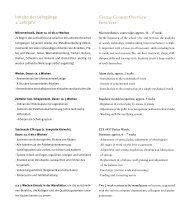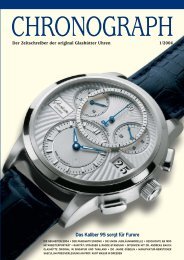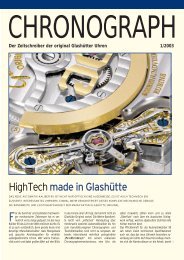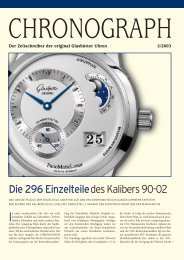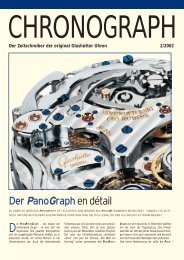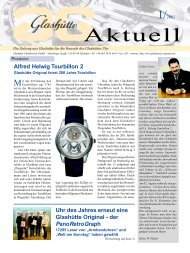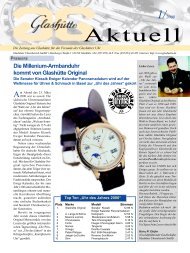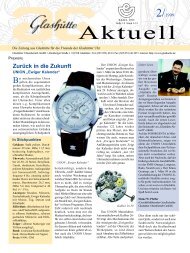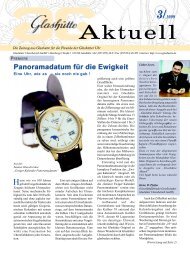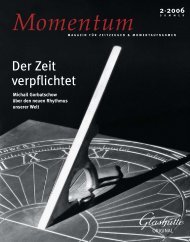2009 Momentum - Glashütte Original
2009 Momentum - Glashütte Original
2009 Momentum - Glashütte Original
Create successful ePaper yourself
Turn your PDF publications into a flip-book with our unique Google optimized e-Paper software.
Time Study Sapphires and rubies<br />
During these processes, about half of the corundum material is<br />
lost as dust.<br />
Then the blanks go through a series of operations performed by<br />
qualified personnel: evening the thickness, forming the exteriors,<br />
beveling, faceting, spherical or cylindrical recessing and doming,<br />
polishing, cleaning, and quality control. It is only after all of these<br />
just about 20 steps have been completed that an imperfection in<br />
a crystal can be seen and declared usable or not. The blanks are<br />
cleaned between each step to ensure that particles of sapphire<br />
residue from the diamond cutting wheels, diamond powder and<br />
cementing resins are completely removed. Any of this left on the<br />
blank will affect the quality of each machining operation. The most<br />
important cleaning step takes place after the final operation. This<br />
allows for a proper visual control of the transparency of the piece<br />
and ensures that only perfect crystals are delivered to the customer.<br />
32 <strong>Momentum</strong> 1· <strong>2009</strong><br />
Senator Sixties Technical data<br />
<strong>Glashütte</strong> <strong>Original</strong>’s designers have captured<br />
the joie de vivre of the 1960s in the<br />
Senator Sixties, greatly characterized by<br />
the domed dial and crystal typical of the<br />
period – though then it would have been<br />
Hesalite rather than sapphire, the latter a<br />
material far more resistant to scratching –<br />
which allow the extra-flat case premium expression<br />
that perfectly matches the arced,<br />
luminescent, skeletonized hands gliding<br />
harmoniously across the satin-finished dial<br />
with diamond-cut hour markers and extra -<br />
vagant numerals. The shaped sapphire crystal<br />
case back allows a direct view into automatic<br />
manufacture Caliber 39-52 with its<br />
characteristic elements of <strong>Glashütte</strong> watchmaking<br />
such as three-quarter plate and<br />
swan-neck fine adjustment. This timepiece<br />
is available with a silver-coloured or black<br />
dial in a rose gold or stainless steel case.<br />
www.glashuette-original.com<br />
The beauty of blue<br />
sapphire lies in the<br />
rich colour of this<br />
corundum variety<br />
Anti-reflective coating is an option for sapphire<br />
crystals. This diffuses every reflection so that the naked eye sees<br />
almost no reflection. The coating is actually a layer of oxide between<br />
three and five microns thick added to the crystal by an evaporation<br />
system in a sterilized laboratory at a temperature of about 280°C.<br />
The crystals can be made anti-reflective either on the underside or<br />
on both sides, and the difference is astounding when you compare<br />
the two side by side. If the watch sports a blue or black dial, an<br />
anti-reflective coating on both sides can almost make the wearer<br />
believe that there is no crystal at all. Likewise, if anti-reflective treatment<br />
is missing, a blue or black dial may prove hard to read. One<br />
drawback of anti-reflective treatment is that it is softer than the<br />
sapphire crystal itself, meaning that although it may be close to<br />
impossible to scratch the crystal – which only a diamond can do<br />
– the anti-reflective coating can easily be scratched. Crystals treated<br />
on one side are 92% anti-reflective, while crystals treated on both<br />
sides are 96% anti-reflective.<br />
Synthetic rubies, today’s standard as bearing jewels,<br />
are, by the way, manufactured the same way. The red boules are<br />
literally sliced using a machine outfitted with a copper and diamond<br />
cutting tool. The slices are halved, squared, and finally cut into<br />
round shapes measuring between 0.3 and 0.5 millimetres in thickness<br />
and 1.15 to 2.55 millimetres in diameter.<br />
Using synthetic sapphire crystal as a watch dial covering became<br />
popular in the late 1960s as it could boast three distinct advantages<br />
over the acrylic and mineral crystals that had mainly been used<br />
until then. Synthetic sapphire is hard – the second hardest substance<br />
available – and therefore can only be scratched, or worked,<br />
by a diamond. Synthetic sapphire is heavy, giving a watch a more<br />
luxurious feel. And synthetic sapphire is still a precious stone, albeit<br />
man-made, making the watch more valuable as a whole – much like<br />
the perception that ruby bearings in a movement exude. ✺



